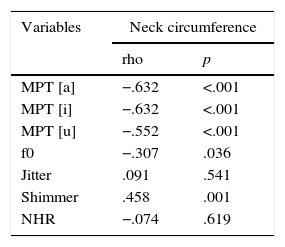Obesity is recognized as a worldwide epidemic. As such, it has consequences for the quality of life of a person and is related to physiological changes that modify body functioning, including vocal production and its normal parameters.
ObjectiveTo investigate the relationship between neck circumference and the acoustic parameters of the voice in women with morbid obesity.
MethodAn observational, cross-sectional comparative study was conducted on a sample of 23 morbidly obese women and 19 women without obesity. Voice recording was performed using the acoustic analysis software ANAGRAF® on a laptop with attached external microphone. To extract the values of the fundamental frequency, jitter, shimmer, and harmonic noise ratio, participants were requested to sustain the emission of the vowel [a], with the usual intensity and pitch. To extract the maximum phonation time, the participants were asked to prolong the vowels [a], [i] and [u] in the usual intensity and pitch. The neck circumference was measured using a paper measuring tape placed perpendicular to the long axis of the neck just below the larynx prominence. The Mann–Whitney test was performed on the data in order to detect differences between groups in relation to the study variables.
ResultsThe variables that had a significant difference between the groups were, the maximum phonation time and the shimmer acoustic parameter. The fundamental frequency and jitter showed different values in the obese group, although this relationship was not statistically significant.
ConclusionThe increase in neck circumference can produce changes in the acoustic parameters of the voice of morbidly obese women.
La obesidad es reconocida como una epidemia de carácter mundial. Tiene consecuencias en la calidad de vida de una persona y se relaciona con los cambios fisiológicos que modifican el funcionamiento del cuerpo, incluyendo la producción vocal y sus parámetros acústicos.
ObjetivoInvestigar la relación entre la circunferencia del cuello y los parámetros acústicos tradicionales de la voz en las mujeres con obesidad mórbida.
MétodoEstudio comparativo observacional, transversal. La muestra consistió en las emisiones de 25 mujeres con obesidad mórbida y 23 mujeres sin obesidad. La grabación de voz se realizó utilizando el software de análisis acústico ANAGRAF®. Para extraer los valores de la frecuencia fundamental, jitter, shimmer, y la relación de ruido armónico, se solicitó a las participantes que sostuvieran la emisión de la vocal [a] durante 3 o 4 segundos con la intensidad y tono habitual. Para extraer el tiempo máximo de fonación los participantes prolongaron la emisión de las vocales [a], [i] y [u]. La circunferencia del cuello se midió por medio de una cinta colocada perpendicularmente al eje longitudinal del cuello justo debajo de la laringe. Los datos se procesaron con la prueba de Mann–Whitney para detectar diferencias entre los grupos en relación con las variables de estudio.
ResultadosLas variables que tuvieron diferencias significativas entre los grupos fueron: el tiempo máximo de fonación y el parámetro acústico shimmer. La frecuencia fundamental y el jitter presentan valores diferentes en el grupo de obesas, aunque este cambio no fue estadísticamente significativo.
ConclusiónEl aumento de la circunferencia del cuello puede producir cambios en algunos parámetros acústicos de la voz de las mujeres con obesidad mórbida.
Artículo
Comprando el artículo el PDF del mismo podrá ser descargado
Precio 19,34 €
Comprar ahora









